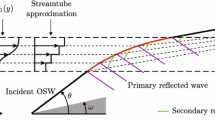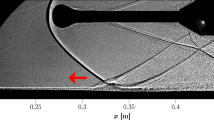Abstract
A direct numerical simulation (DNS) on an oblique shock wave with an incident angle of 33.2° impinging on a Mach 2.25 supersonic turbulent boundary layer is performed. The numerical results are confirmed to be of high accuracy by comparison with the reference data. Particular efforts have been made on the investigation of the near-wall behaviors in the interaction region, where the pressure gradient is so significant that a certain separation zone emerges. It is found that, the traditional linear and logarithmic laws, which describe the mean-velocity profiles in the viscous and meso sublayers, respectively, cease to be valid in the neighborhood of the interaction region, and two new laws of the wall are proposed by elevating the pressure gradient to the leading order. The new laws are inspired by the analysis on the incompressible separation flows, while the compressibility is additionally taken into account. It is verified by the DNS results that the new laws are adequate to reproduce the mean-velocity profiles both inside and outside the interaction region. Moreover, the normalization adopted in the new laws is able to regularize the Reynolds stress into an almost universal distribution even with a salient adverse pressure gradient (APG).
Similar content being viewed by others
References
Gaitonde, D. V. Progress in shock wave/boundary layer interactions. Progress in Aerospace Sciences, 72, 80–99 (2015)
Chapman, D. R., Larson, H. K., and Kuehn, D. M. Investigation of separated flows in supersonic and subsonic streams with emphasis on the effect of transition. NASA Technical Reports, NASA, United States (1957)
Stewartson, K. and Williams, P. G. Self-induced separation. Proceedings of the Royal Society of London, A312, 181–206 (1969)
Neiland, V. Y. Theory of laminar boundary layer separation in supersonic flow. Fluid Dynamics, 4, 33–35 (1972)
Adamson, T. C. and Messiter, A. F. Analysis of two-dimensional interactions between shock waves and boundary layers. Annual Review of Fluid Mechanics, 12, 103–138 (1980)
Roy, J. C. and Blottne, G. F. Review and assessment of turbulence models for hypersonic flows. Progress in Aerospace Sciences, 42, 469–530 (2006)
Settles, G. S. and Dodson, L. J. Hypersonic shock/boundary layer interaction database. NASA Technical Reports, NASA, United States (1991)
Knight, D., Yan, H., Panaras, A. G., and Zheltovodov, A. Advances in CFD prediction of shock wave turbulent boundary layer interactions. Progress in Aerospace Sciences, 39, 121–184 (2003)
Pirozzoli, S. and Grasso, F. Direct numerical simulation of impinging shock wave/turbulent boundary layer interaction at M = 2.25. Physics of Fluids, 18, 1–17 (2006)
Ganapathisubrama, B., Clemens, N. T., and Dolling, D. S. Low-frequency dynamics of shockinduced separation in a compression ramp interaction. Journal of Fluid Mechanics, 636, 397–436 (2009)
Humble, R. A., Scarano, F., and van Oudheusden, B. W. Unsteady flow organization of a shock wave/turbulent boundary layer interaction. Journal of Fluid Mechanics, 635, 47–74 (2009)
Piponniau, S., Dussauge, J. P., Debieve, J. F., and Dupont, P. A simple model for low-frequency unsteadiness in shock-induced separation. Journal of Fluid Mechanics, 629, 87–108 (2009)
Touber, E. and Sandham, N. D. Large-eddy simulation of low-frequency unsteadiness in a turbulent shock-induced separation bubble. Theoretical and Computational Fluid Dynamics, 23, 79–107 (2009)
Pirozzoli, S. and Bernardini, M. Direct numerical simulation database for impinging shock wave/turbulent boundary-layer interaction. AIAA Journal, 49, 1307–1312 (2011)
Priebe, S. and Martin, M. P. Low-frequency unsteadiness in shock wave-turbulent boundary layer interaction. Journal of Fluid Mechanics, 699, 1–49 (2012)
Priebe, S., Tu, J. H., Rowley, C.W., andMartin, M. P. Low-frequency dynamics in a shock-induced separated flow. Journal of Fluid Mechanics, 807, 441–477 (2016)
Morgan, B., Duraisamy, K., Nguyen, N. S., Kawai, S., and Lele, K. Flow physics and RANS modelling of oblique shock/turbulent boundary layer interaction. Journal of Fluid Mechanics, 729, 231–284 (2013)
Edwards, J. R. Numerical simulations of shock/boundary layer interactions using time-dependent modeling techniques: a survey of recent results. Progress in Aerospace Sciences, 44, 447–465 (2008)
Knight, D., Longo, J., Drikakis, D., Gaitonde, D., Lani, A., Nompelis I., Reimann, B., and Walpot, L. Assessment of CFD capability for prediction of hypersonic shock interactions. Progress in Aerospace Sciences, 48-49, 8–26 (2012)
Loginov, M. S., Adams, N. A., and Zheltovodov, A. A. Large-eddy simulation of shockwave/turbulent-boundary-layer interaction. Journal of Fluid Mechanics, 565, 135–170 (2006)
Wilcox, D. C. Turbulence Modeling for CFD, DCW Industries, United States (1998)
Duan, L., Beekman, I., and Martin, M. P. Direct numerical simulation of hypersonic turbulent boundary layers: part 3, effect of Mach number. Journal of Fluid Mechanics, 672, 245–267 (2011)
Skote, M. and Henningson, D. S. Direct numerical simulation of a separated turbulent boundary layer. Journal of Fluid Mechanics, 471, 107–136 (2002)
Gungor, A. G., Maciel, Y., Simens, M. P., and Soria, J. Scaling and statistics of large-defect adverse pressure gradient turbulent boundary layers. International Journal of Heat and Fluid Flow, 59, 109–124 (2016)
Qin, H. and Dong, M. Boundary-layer disturbances subjected to free-stream turbulence and simulation on bypass transition. Applied Mathematics and Mechanics (English Edition), 37 (8), 967–986 (2016) DOI 10.1007/s10483-016-2111-8
Li, X. L., Fu, D. X., Ma, Y. W., and Liang, X. DNS of Shock/Boundary Layer Interaction Flow in a Supersonic Compression Ramp, Springer-Verlag, Heidelberg, 729–737 (2011)
Li, X. L., Leng, Y., and He, Z. W. Optimized sixth-order monotonicity-preserving scheme by nonlinear spectral analysis. International Journal for Numerical Methods in Fluids, 73 (6), 560–577 (2013)
Li, X. L. Direct numerical simulation techniques for hypersonic turbulent flows. Hangkong Xuebao/ Acta Aeronautica et Astronautica Sinica, 36, 147–158 (2015)
Zheltovodov, A. A. Analysis of properties of two-dimensional separated flows at supersonic speeds conditions (in Russian). Investigations of Near-wall Flows of Viscous Gas, USSR Academy of Sciences, Russia, 59–94 (1979)
Zheltovodov, A. A. Shock waves/turbulent boundary-layer interactions—fundamental studies and applications. Journal of Chemical Physics, 67, 677–698 (2013)
Vulis, L. A. and Kashkarov, W. P. Theory of the Viscous Liquid Jets, Nauka, Moscow (1965)
Acknowledgements
The authors are grateful to Professor Xinliang LI of Institute of Mechanics, Chinese Academy of Sciences for kindly providing the DNS code. Professors Heng ZHOU and Jisheng LUO of Tianjin University are also acknowledged for their valuable discussion and suggestions. This work is carried out at the National Supercomputer Center in Tianjin, and the calculations are performed on TianHe-1 (A).
Author information
Authors and Affiliations
Corresponding author
Additional information
Project supported by the National Natural Science Foundation of China (Nos. 11472189 and 11332007)
Rights and permissions
About this article
Cite this article
Ye, M., Dong, M. Near-wall behaviors of oblique-shock-wave/turbulent-boundary-layer interactions. Appl. Math. Mech.-Engl. Ed. 38, 1357–1376 (2017). https://doi.org/10.1007/s10483-017-2248-6
Received:
Revised:
Published:
Issue Date:
DOI: https://doi.org/10.1007/s10483-017-2248-6
Key words
- shock wave
- turbulent boundary layer
- direct numerical simulation (DNS)
- adverse pressure gradient (APG)
- separation




